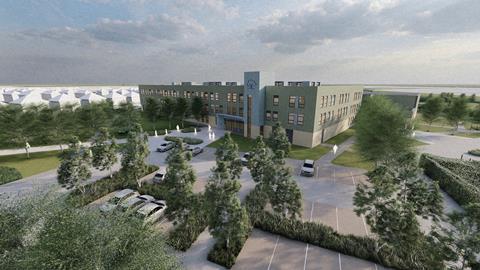There are many challenges when building in an urban setting, but resolving them using on-site natural resources is good for the environment and good for the wellbeing of those who live or work there. Simon Wyatt urges more designers to work this way

In recent months, I have focused on the policy and financial drivers of sustainable design, and, while these are an essential part of how we achieve net zero carbon in the built environment, it is also important to consider how we use the natural resources offered by the sites that we build on to minimise the carbon impact of the environments we design.

One of the key themes of COP26 is adaptation and resilience, and both present an opportunity to prioritise nature-based solutions – natural measures and processes that solve design problems. These include using rain gardens as part of sustainable drainage systems (SuDS) strategies, using ponds and lakes for natural driven evaporative cooling and using tree canopies for shading during heat waves.
However, nature-based solutions could be used for all design challenges, based on a hierarchy of design where natural solutions are preferred over artificial solutions. We are already seeing this in the SuDS hierarchy, which has a precedence for swales and green roofs before looking at underground storage tanks. By using a nature-based solutions approach, we can start to address both the climate and biological emergencies simultaneously, while providing better-quality spaces for people and nature.
By using a nature-based solutions approach, we can start to address both the climate and biological emergencies, while providing better quality spaces for people and nature
One of the greatest challenges in urban environments is the urban heat island effect. This is the absorption of solar energy by hard surfaces and subsequent re-radiation, which causes elevated temperatures in urban environments and will only get worse as global mean temperatures rise. By introducing more soft landscaping and planting, temperatures can be reduced, consequently improving the environmental quality of spaces for occupants and residents. This also reduces the need for mechanical cooling solutions, and therefore energy consumption.
> Also read: Countdown to COP26: Are we building with the climate of the future in mind?
The UK Green �ڶ����� Council (UKGBC) has linked the nature-based solutions programme with the climate adaptation programme and is providing several case studies to demonstrate their co-benefits. One of these case studies is the Ignition project with the Greater Manchester combined authority, which aims to develop innovative financing solutions for investment in the region’s natural environment. This investment will help to build Manchester’s ability to adapt to the increasingly extreme impacts of climate change by working with nature, and utilising solutions such as rain gardens, street trees, green roofs and walls. It will also include the development of green spaces to help tackle socio-environmental challenges like an increase in flooding events, water security, air quality, biodiversity, and human health and wellbeing.
| 1 | Store rainwater for later use |
| 2 | Use infiltration techniques, such as porous surfaces in non-clay areas |
| 3 | Attenuate rainwater in ponds or open water features for gradual release |
| 4 | Attenuate rainwater by storing in tanks or sealed water features for gradual release |
| 5 | Discharge rainwater direct to a watercourse |
| 6 | Discharge rainwater to a surface water sewer or drain |
| 7 | Discharge rainwater to the combined sewer |
Several large developers are also looking at using nature-based solutions as part of their net zero carbon pathways by including their wider estates within their carbon offsetting strategies. The Crown Estate, for example, has identified opportunities for carbon sequestration and restoring nature by encouraging biodiversity in its marine and rural estates to address both the climate and ecological emergencies.
The big question is: why are we not using nature-based solutions even more to resolve design issues?
Simon Wyatt is sustainability partner at Cundall
Chilmington Green School: a case study in sustainable design
Set among some rolling hills in the verdant Kentish countryside, when complete, Chilmington Green School will be an exemplar net zero carbon school project that showcases the benefits of using nature-based solutions (Alan Fogarty writes).
Part of a pilot project to design and build net zero carbon schools by Cundall and Bowmer & Kirkland, with landscape architect Ares, Chilmington Green School is being developed in response to the Department for Education’s (DfE) net zero carbon agenda, which places a strong emphasis on biodiversity and adaptation.

While the benefits of landscaping have long been appreciated in terms of the urban heat island effect, as well as enhanced biodiversity and sustainable drainage systems (SuDS), quantifying that benefit is more difficult. Until now there has been very little documented research to back up the anecdotal findings.
One of three schools currently being designed by the group as part of the pilot scheme, Chilmington Green is being driven by the DfE’s agenda, and by the joint ambition of Cundall and Bowmer & Kirkland to create a more sustainable built environment. They initiated a body of research as part of the project, aiming to quantify the benefits of nature-based solutions in order to create properly designed solutions for schools. Chilmington Green School is the first one to which it is being actively applied.
Issues being considered include:
- Moving hard surfaces, which attract and retain the heat in summer, away from the buildings.
- Introducing protective landscaping such as trees, which provide shading externally and cool down the surrounding landscape; designing and locating the building on the site in a way that takes advantage of prevailing winds and allows further cooling by the protective landscape. Research indicates that temperatures can be lowered by up to 3ºC around the buildings, greatly enhancing the thermal comfort of the occupants as well as reducing the need for carbon-intensive mechanical solutions.
- Incorporating water features in the landscaping to reduce heat build-up and actively cool the ambient air.
- Utilising new or existing woodlands, which shades the earth below the trees, retains moisture and keeps things cool. It also creates a turbulent effect, where cooler air passing over the trees tumbles down to cool the environment below them.
- Introducing features into the landscaping that draw cooler air down from a high level to cool the layer at ground level. For example, a sloped canopy to catch the wind and direct the cooler air to ground level as the air passes under it.
It is further appreciated that the introduction of landscaping – especially trees around buildings – promotes a biophilic response within the building itself. It has been proven to enhance the perceived thermal comfort of occupants, making people more relaxed and tolerant of any discomfort. This in turn leads to enhanced performance, so for schoolchildren this means a better, more productive learning environment.
As previously discussed, trees provide shading for the buildings, as well as for outdoor teaching areas. This can be particularly useful for the east and west side facades, where they can be effective at providing shading from low sun angles, while deciduous trees in the south provide shading in summer and allow for solar collection in the winter months.
Alan Fogarty is sustainability partner at Cundall



























No comments yet